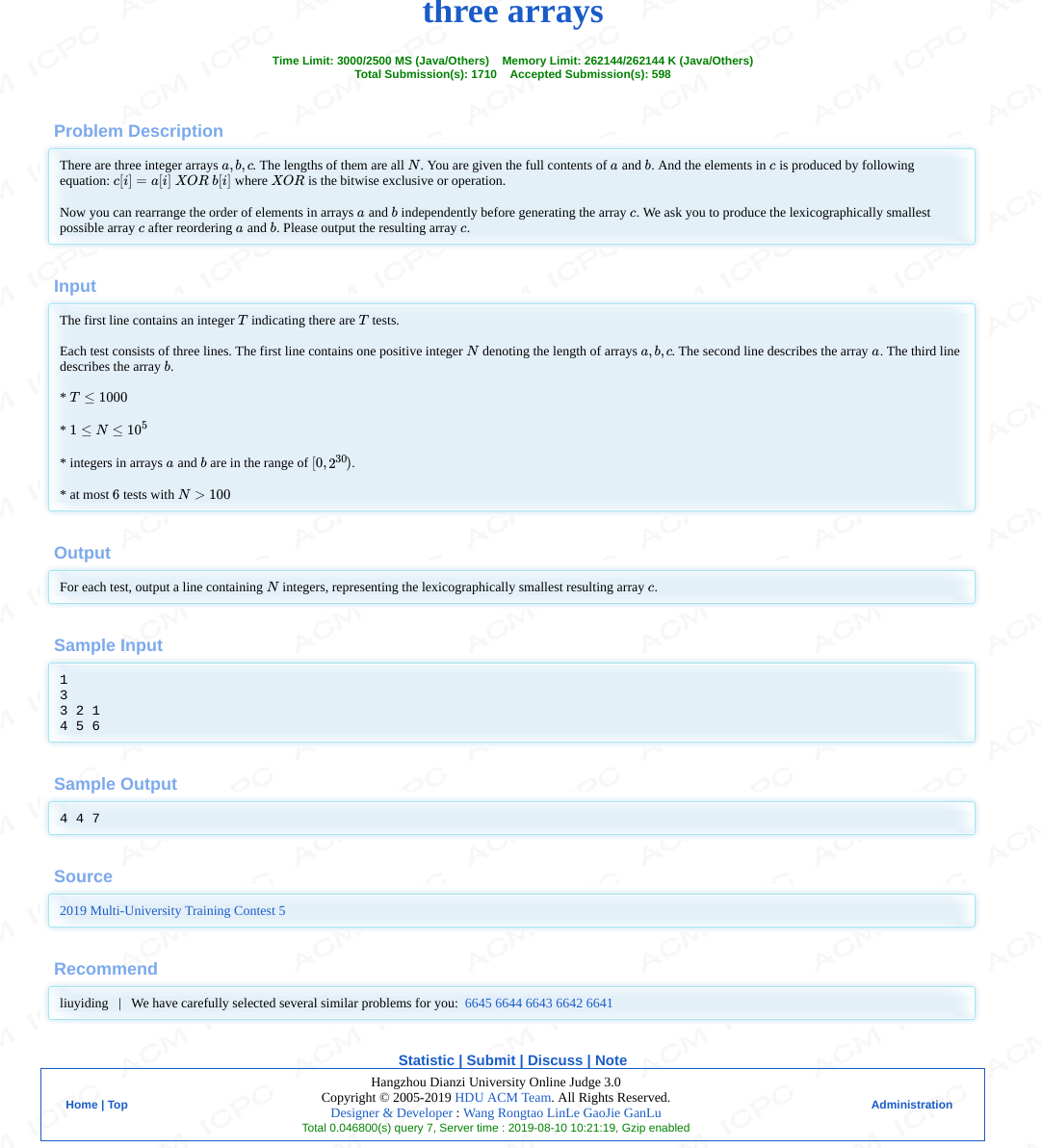标签:array new stdin 个人 匹配 cto trie ons 数字
@(hdu 6625求两个序列异或最小值的排列)
\(T(100)\)组,每组两个长度为\(n(100000)\)的排列,你可以将\(a[]\)和\(b[]\)随机排列,可以得到\(c[i]=a[i]\)^\(b[i]\),求字典序最小的\(c[]\)。
一个显然对的贪心做法:
针对本题
一个可以推广的正解:
Code1
const int MXN = 1e5 + 7;
const int MXE = 2e6 + 7;
int n, m;
int ar[MXN], br[MXN];
struct Trie {
int tot;
int nex[MXE][2], num[MXE], val[MXE];
Trie(){nex[0][0] = nex[0][1] = -1;}
void newnode() {
++ tot;
nex[tot][0] = nex[tot][1] = -1;
}
void inisert(int x) {
int rt = 0;
for(int i = 31, tmp; i >= 0; --i) {
tmp = ((x>>i)&1);
if(nex[rt][tmp] == -1) newnode(), nex[rt][tmp] = tot;
rt = nex[rt][tmp];
num[rt] ++;
}
val[rt] = x;
}
void del(int x) {
int rt = 0;
for(int i = 31, tmp; i >= 0; --i) {
tmp = ((x>>i)&1);
int lst = rt;
rt = nex[rt][tmp];
nex[lst][tmp] = -1;
num[rt] = 0;
}
}
}cw[2];
bool check(int id, int rt, int tmp) {
return cw[id].nex[rt][tmp] != -1 && cw[id].num[cw[id].nex[rt][tmp]] > 0;
}
int getans() {
int rt1 = 0, rt2 = 0;
for(int i = 31; i >= 0; --i) {
if(check(0, rt1, 0) && check(1, rt2, 0)) {
rt1 = cw[0].nex[rt1][0];
rt2 = cw[1].nex[rt2][0];
-- cw[0].num[rt1];
-- cw[1].num[rt2];
}else if(check(0, rt1, 1) && check(1, rt2, 1)) {
rt1 = cw[0].nex[rt1][1];
rt2 = cw[1].nex[rt2][1];
-- cw[0].num[rt1];
-- cw[1].num[rt2];
}else if(check(0, rt1, 1) && check(1, rt2, 0)) {
rt1 = cw[0].nex[rt1][1];
rt2 = cw[1].nex[rt2][0];
-- cw[0].num[rt1];
-- cw[1].num[rt2];
}else if(check(0, rt1, 0) && check(1, rt2, 1)) {
rt1 = cw[0].nex[rt1][0];
rt2 = cw[1].nex[rt2][1];
-- cw[0].num[rt1];
-- cw[1].num[rt2];
}
}
return cw[0].val[rt1] ^ cw[1].val[rt2];
}
int main() {
#ifndef ONLINE_JUDGE
freopen("/home/cwolf9/CLionProjects/ccc/in.txt", "r", stdin);
// freopen("/home/cwolf9/CLionProjects/ccc/out.txt", "w", stdout);
#endif
int tim = read();
while(tim --) {
n = read();
cw[0].tot = cw[1].tot = 0;
for(int i = 1; i <= n; ++i) ar[i] = read(), cw[0].inisert(ar[i]);
for(int i = 1; i <= n; ++i) br[i] = read(), cw[1].inisert(br[i]);
vector<int> vs;
for(int i = 1; i <= n; ++i) vs.eb(getans());
sort(all(vs));
for(int i = 0; i < SZ(vs); ++i) printf("%d%c", vs[i], " \n"[i == SZ(vs) - 1]);
for(int i = 1; i <= n; ++i) cw[0].del(ar[i]), cw[1].del(br[i]);
}
return 0;
}Code2
const int MXN = 1e5 + 7;
const int MXE = 2e6 + 7;
int n, m;
int ar[MXN], br[MXN];
struct Trie {
int tot;
int nex[MXE][2], num[MXE], val[MXE];
Trie(){nex[0][0] = nex[0][1] = -1;}
void newnode() {
++ tot;
nex[tot][0] = nex[tot][1] = -1;
}
void inisert(int x) {
int rt = 0;
for(int i = 30, tmp; i >= 0; --i) {
tmp = ((x>>i)&1);
if(nex[rt][tmp] == -1) newnode(), nex[rt][tmp] = tot;
rt = nex[rt][tmp];
num[rt] ++;
}
val[rt] = x;
}
int query(int x) {
int rt = 0;
for(int i = 30, tmp; i >= 0; --i) {
tmp = ((x>>i)&1);
if(nex[rt][tmp] != -1 && num[nex[rt][tmp]]) rt = nex[rt][tmp];
else rt = nex[rt][!tmp];
}
return val[rt];
}
int find() {
int rt = 0;
for(int i = 30, tmp; i >= 0; --i) {
if(nex[rt][0] != -1 && num[nex[rt][0]]) rt = nex[rt][0];
else if(nex[rt][1] != -1 && num[nex[rt][1]]) rt = nex[rt][1];
}
if(rt == 0) return -1;
return val[rt];
}
void del() {
for(int i = 0; i <= tot + 1; ++i) num[i] = 0, clr(nex[i], -1);
tot = 0;
}
void sub(int x) {
int rt = 0;
for(int i = 30, tmp; i >= 0; --i) {
tmp = ((x>>i)&1);
rt = nex[rt][tmp];
num[rt] --;
}
}
}cw[2];
/*
* 这种做法不能保证每次求出来的异或最小值都是单调递增的,但是将n次得到的值排序后一定是正确答案
* 如果想单纯的求两个01字典树异或最小值,个人感觉还没有较好的复杂度的做法。
* 关于本题,还有一个出题人提供适用性更加广泛的正解:
* 现在a中随便找一个数字,然后在b中找一个和他匹配最小的数字,再在a里面找一个和上个数匹配最小的数字,递归下去一定会找到一个大小为2的环
* 把这个环取出来,在回到上一个位置继续递归下去。得到的n个数字排序即为最终答案。
* */
vector<int> vs;
int dfs(int id, int x, int lst) {
int tmp = cw[!id].query(x);
if(tmp == lst) {
vs.eb(tmp ^ x);
cw[id].sub(x);
cw[!id].sub(tmp);
return id;
}
int ret = dfs(!id, tmp, x);
if(ret != id) return ret;
}
int main() {
#ifndef ONLINE_JUDGE
freopen("/home/cwolf9/CLionProjects/ccc/in.txt", "r", stdin);
// freopen("/home/cwolf9/CLionProjects/ccc/out.txt", "w", stdout);
#endif
int tim = read();
while(tim --) {
n = read();
for(int i = 1; i <= n; ++i) ar[i] = read(), cw[0].inisert(ar[i]);
for(int i = 1; i <= n; ++i) br[i] = read(), cw[1].inisert(br[i]);
vs.clear();
while(1) {
int tmp = cw[0].find();
if(tmp == -1) break;
dfs(1, tmp, -1);
}
sort(all(vs));
for(int i = 0; i < SZ(vs); ++i) printf("%d%c", vs[i], " \n"[i == SZ(vs) - 1]);
cw[0].del(), cw[1].del();
}
return 0;
}
HDU 6625 three arrays 求两个序列异或最小值的排列(一个可以推广的正解
标签:array new stdin 个人 匹配 cto trie ons 数字
原文地址:https://www.cnblogs.com/Cwolf9/p/11330789.html